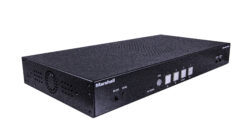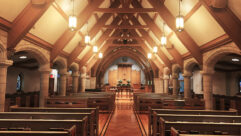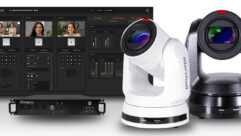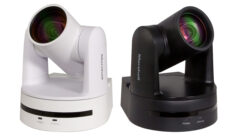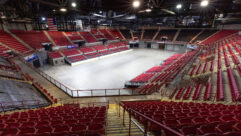
A Loudspeaker Disussion with Marshall Kay and Don Keele
Dec 15, 2011 11:10 AM,
With Bennett Liles
Listen to the Podcasts
Editor’s note: For your convenience, this transcription of the podcast includes timestamps. If you are listening to the podcast and reading its accompanying transcription, you can use the timestamps to jump to any part of the audio podcast by simply dragging the slider on the podcast to the time indicated in the transcription.
It’s great when an AV contractor can get in on the design phase of a new church sanctuary. Marshall Kay and Don Keele of Audio Artistry in Raleigh, N.C., are here to tell us how they used that ace card to provide great sound for the Cary Church of God, coming up next for the SVC Podcast.
OK, Marshall and Don, thanks for being here for the SVC Podcast from Audio Artistry in Raleigh, N.C. We’re going to be talking about a very interesting installation that you guys were both in on at the Cary Church of God. Marshall, first though to get things rolling here, tell me a little about Audio Artistry.
Marshall: OK, first off thanks for having us. We’re delighted to be here. We’re excited about telling you about what we’ve done here. We think we’ve done some exciting things and there’s a lot of new technology that we’ve explored and so we’re very interested in sharing that. Anyway, Audio Artistry was founded in 1992 by myself and another fellow by the name of Kurt Pasquale, who’s not actively engaged with the company these days. But we started out first building a speaker that was sold through the local audio stores here in town that interfaced with tube amplifier raids that was going on about that time. Cary Audio was a big company in the area here, and he was working on a new tube amplifier and we set our first speaker out to stereo file along with one of his amplifiers. This was when we first got some attention in the industry—from a major magazine and then in 1994, we incorporated. I had known Siegfried Linkwitz for quite some time, and I had known he was working on a dipole-type loudspeaker that was very interesting to me, and the speaker he was working on at that time was a fully active dipole. It actually had four amplifiers per side and after a period of time, I convinced him that we needed to make that speaker into at least a two-way active speaker rather than a four-way. The first product we introduced with that technology was called a Dvorak. It came out, and we showed that first at 1994 at the CES Show. Building the dipole-style speakers we were able to finally achieve the Stereo File Speaker of the Year Award in 1998 and then later on in time we moved more into a wider variety of things mostly because of requests when we moved into working with larger facilities and PA and that sort of thing. [Timestamp: 2:53]
Sounds like you’ve been pretty busy. Now this Cary Church of God installation project, you had an Aviom system that you put in for sound distribution on their services. What sort of church is the Cary Church of God? What are their worship style like?
Well, Cary Church of God has been around since roughly the early 80’s. It was formed in a house and they have grown at a rapid rate, and I actually have attended that church myself and have been going there for quite some time. It’s a Pentecostal-style worship and they have a 50-60 voice choir, normally use bass, drums, acoustic guitar, electric guitar, as many as two keyboards—sometimes three, also they have some woodwind-type instruments like saxophone occasionally and trumpet occasionally that join in in the service. [Timestamp: 3:40]
OK, obviously a lot going on in the technical level during their services. So what was the situation at the church when they called you in for this job? What exactly did they need you to do there?
In the early 2000, roughly 2004-2005, the growth of the church was such that they had decided to seek land for a new facility, and the church staff knew that I was involved heavily in audio and they came to me and asked me to engage with the architect that they were working with to make sure that we had a facility that would be conducive for state of the art sound and state of the art video and lighting and that sort of thing. So I got involved very early in the design phase of the project, so I was able to work with the architect; it turned out, actually, I worked with three different architects over the course of the project because the scope of the building changed and also the choice of contractor changed over time, but we worked with these three architects to specify not only the layout of the building in terms of where equipment would be located—the air conditioning in the building, the lighting, the power, all those things were specified through the design phase. We even at one point brought in an acoustical consultant that did an EASE model on the auditorium to make sure that we didn’t have any reverb issues. [Timestamp: 5:02]
And that’s always a huge advantage being able to get in on the design phase and have some input on the basic layout and the electrical setup and everything. I know they had a Yamaha M7CL mixer for the front of house. Was that already there or was that something you suggested?
That was actually part of the building phase, but it was purchased early in the building cycle because the sound team wanted to become familiar with it before moving to the new facility. So that was bought, I guess, maybe six months to nine months ahead of the new building so it gave them time to get familiar with it. The new concept to the sound team—they had been running analog boards, in fact Allen and Heath—I think it was a 32-channel board that they had been using and then switching to the M7CL, which gave them a lot more flexibility and control, added a whole new dimension to running sound. But in the end, it turns out it’s a much easier and not as big of a learning curve as some people might think once the thing is configured and set up and working properly. [Timestamp: 6:01]
So how do they record the services there? Do they use multitrack or how do they handle that?
Well, there’s two things that take place there. The services are video—we have video that is recorded; we record audio, and there’s a separate control room where that’s all handled. In that control room there’s a person who runs an O2R96 Yamaha board then the video is mixed there and then they’re merged together and then that feeds the campus video for the nurseries and for fellowship court and the foyer in that area. But we also stream the services from that record control room but that mix and that video mix comes from that room. [Timestamp: 6:40]
And as you said you got in on the ground floor of the design phase on the place. So did you have any sort of power issues when the upgrade started? Did you have to add anything to it for the equipment?
Actually since we were able to specify the power during the design phase, we actually specified transformers for the audio side. So audio is completely isolated from all the other electrical circuits in the house and the audio is on a separate transformer with a Faraday shield in the main power system. [Timestamp: 7:10]
OK and they’ve got wireless gear in there. Is that mics and ear monitors? What type of wireless gear do the performers use?
The microphones that we use are the Shure UHL series and there’s, I think, 12 of those that are running and then each praise team member—the praise team is composed of six people, and each one those people have a wireless in-ear monitor and that is controlled by a personal mixer from the Aviom system so each one can control their own mix and set it exactly as they like and then they’re free to roam around the stage as they choose. [Timestamp: 7:47]
A Loudspeaker Disussion with Marshall Kay and Don Keele
Dec 15, 2011 11:10 AM,
With Bennett Liles
OK and you put an Aviom system in there and I know does more than just handle stage monitoring. How does that fit into the bigger picture for signal distribution in the church?
Well, the Aviom system is really the backbone of the entire system. We switched it to the Pro64; it was a 16-channel system earlier on and then we went to the Pro64, which provides essentially a bus over a single Ethernet cable of 64 channels of audio bi-directionally. So audio routes from the stage, which is picked up from each of the instruments and then also the microphones is a pre-amp there for any microphones like the choir mics and that sort of thing and mics for any live drums and acoustic guitars and that sort of thing. And then it busses it back to the M7. Part of the choice of choosing a Yamaha M7 and an O2R96 is that they can natively accept a card that’s manufactured by Aviom and it plugs into the back of those mixing boards and accepts this bus of audio coming in and then we can pull channels from that bus as needed for that particular mixing board. So from the M7, which is the house board, the audio routes right out of it over the Ethernet cable up to the O2R96, which then pulls out the channels it needs for the 2-channel mix and then from there it routes out of the O2R96 into another system; it breaks up the audio for a 48-track recorder. So we can record for all 48 tracks of audio simultaneously and then do postproduction if necessary on the audio and then finally the bus routes back down to the stage after the mix is complete at the M7 and that routes the audio back down for the monitoring system. We use three CBT arrays that fly above the choir for stage monitoring, and it also feeds the amplifier rack for the main house speakers, which are again the CBTs and the subwoofer. All this infrastructure of audio is essentially controlled entirely by this Aviom system, which basically replaces the old multichannel snakes that we used to use and the reliability of this system is so good. It’s just as good as using the analog snakes. In fact, in some ways, more reliable because in several years now of using Aviom Viewer, we’ve had very little problems with it. It’s very reliable. It’s a very good way to go; it’s very clean and just cleans up all the wiring enormously. [Timestamp: 10:19]
And I understand that there was a new sort of line array technology was deployed in this system. I hear that it was originally developed by the Navy.
When we first started down this path, I searched back in time—roughly to 1930—reading as many papers as I could find on line arrays and having experimented with line arrays prior, in the year 2000, I had built a line array for an event that was a millennium event; it was concert for our church. It was in a very large reverberant space. It was an auditorium here in Raleigh, N.C. called Dorton Arena and this arena is primarily glass on all the windows. It was extremely reverberant, so I knew that I had to use some sort of line array technology to get intelligible sound in this place for a large concert. So we tested and constructed a straight line array and used a frequency-to-main-type shading and that line array ended up being about 25ft. in length on each side. So two 25ft. lines that consisted of a total of 84 12in. drivers, and it had large horns that took over at 400Hz and then on up to 1200Hz. So it worked pretty well, but after having worked with that type of technology, I realized that that wasn’t going to be the best way to implement a line array, so I started researching trying to find a better way to do it. There was new technology that Don Keele had been working on, so I headed off and started researching that. When I found the papers that Don had written, it didn’t take long to realize that this was not only a fantastic way to do a line array, it was probably the only way to do a good line array. And so I called Don up and told him I was thinking about building one of these units, and at the time he was working for Harman Research and I didn’t want to burn too much of his time because I didn’t know how busy he was at the time. So I went off and tried to figure out how to build this thing on my own and actually built three of these lines for our church. But I’m going to let Don take it from here because he can explain the theory behind the technology and why it works so well and give you more insight on all the research he has done into this. [Timestamp: 12:31]
OK Don.
Don: OK well thank you. I certainly appreciate being able to contribute to this. Some of your readers may know, I’ve been around in the industry for a long time. I’ve worked for Electro-Voice twice, Klipsch and Associates, Crown and JBL twice, Harman International. The main things I’m known for is I worked on some large constant conductivity horns while I was at Electro-Voice in the early 70’s; they’re large white fiberglass horns, HR 9040 or HR 6040, and I have a patent on that so I’m very much tuned into constant directivity—that was speaker horns and the first things I worked for JBL the first time around; they put me to work working on a series of loudspeaker horns that would competing with the Electro-Voice horns, but at the time I had run across a series of technical papers, which appeared in the Acoustical Society of America in the late 70’s and early 80’s that had to do with some underwater sound research done by the US Navy concerning so called “constant beamwidth transducers”—so the acronym there is CBT. And they applied this to underwater sonar transducers, which are based on spherical caps, and I thought I it would look like a really neat application in technology; and at the time I thought it would contribute to me designing much better loudspeaker horns, but it ended up that it didn’t work that way. But in any case, I picked this technology up in the late 90’s and thought it would be good to apply them to loudspeaker arrays and that’s what happened. I’ve written, since 2000 up until last year, I’ve written six papers. The first paper I wrote was on my own and this was patent techniques that Harman has two patents on and actually JBL a series of CBT series loudspeaker arrays—small arrays—that you could put in churches, etc., and they currently are doing that. Another application right now professional wise is Lauri Fincham of THX has a line of home theater systems. But in any case Marshall Kay, using guidance from my technical papers, constructed these three large 12ft.-high speaker arrays, which he has in the sanctuary of Cary Church of God in the left center right configuration. The CBT array technology allows you to do a loudspeaker array, which has extremely uniform polar response—particularly in the vertical plane—and you end up with a polar response which is so uniform that it doesn’t even have a near field. By that I mean that the polar pattern doesn’t change when you go from very far distances up to very close and they’re easy put in in and installation and don’t require any special tuning at all. Marshall’s arrays were very successful. He named them in such a manner to cover, well, basically the rear up to the front row of the seating area, and it covers that exceedingly well and then the coverage beyond the front row is also very uniform but quite low and level, which allows the pastor to aim that talk in his lapel microphone beyond the front row. Sometimes loudspeaker arrays are particularly designed to cover a specific area but the coverage in other areas, which is outside of the main beam, is not uniform at all. You can potentially end up with beams going in different directions that are frequency dependent and that makes it very hard to get any gain before feedback in the areas where they aren’t aimed but the CBT arrays are quite unique in that you can get a constant beamwidth, constant directivity, constant sound power radiation into the space and it makes it much easier both in and out of the designed area. So this is something that Audio Artistry now is trying to take advantage of and possibly present some speakers for the professional industry. [Timestamp: 16:26]
So what’s coming up next for Audio Artistry? Have you got some projects in the works right now?
We’re going to be launching a speaker that will be sold worldwide through a company called Parts Express. It will be a kit that anyone can buy the kit and build the speaker. It can be set up in two different formats; one format is called a plane version which can be used for home theater; it can be used for just high-end audio system, you can put these speakers together, the bottoms of them together, and form a 10ft. high array that can be flown in an auditorium and used in an auditorium environment like a gymnasium for instance. So one of our next projects that we intend to do is take this kit speaker and install it in a very live gymnasium to see what sort of results we get. [Timestamp: 17:13]
All right, well I appreciate the two of you being here. Marshall Kay and Don Keele from Audio Artistry in Raleigh, N.C. Thanks guys.


